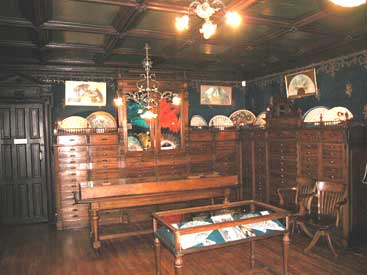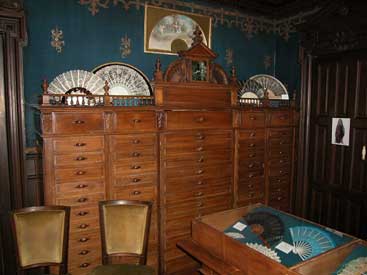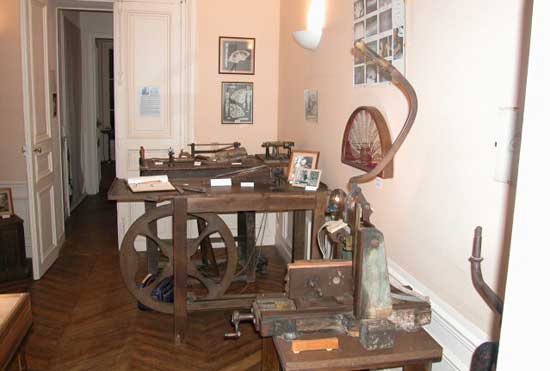

The museum of the fan (Paris)
It is a true museum, but also a workshop. It presents at the same time the techniques of manufacture as well as an extraordinary permanent collection of fans of the XVIIème century at our days.
History:
1872 : In Sainte-Geneviève in Oise, cradle of the tablettery, Joseph
Hoguet Duroyaume created his workshop of mountings of fans. The sheet which covered the
high part of the part was decorated and assembled in Paris.
Mountings of fans, manufactured among "tabletiers" of Oise, were worked in noble
matters as white mother-of-pearl, give lustre to the East, the burgau, black
mother-of-pearl, the scale of tortoise, the bone, the horn, invaluable wood. All this work
was worked, carved, openwork, engraved, encrusted with the fine gold. Mountings were
presented at the Parisian eventaillists who were charged to assemble on those the sheets
in skin of swan, velin, with paintings with mythological topic, silks with gallant scenes,
laces the needle-point with the needle or the spindle, spangled organzas; they were to
also ensure the sale of it.
1927 : The Hoguet family perpetuated the manufacture of fans by adding to it the accessories of mode for the Haute couture, the jewellery and the tablettery of art.
1960 : Herve Hoguet buys goodwill of one of the most prestigious
houses of fans of the 19th century, KEES's house, 2 boulevard from Strasbourg in
Paris, one of the last eventaillists, located on the grand boulevards.
With the wire of time, the request for fans decreased considerably. The house of Paris
however remained thanks to the work of the tablettery and creation of jewels carried out
in the Sainte-Geneviève workshop.
Currently, one of the girls of Herve Hoguet, Anne, named Main of Art in 1994, carries out
in the Parisian workshop of work of restoration of fans for whole France. It also makes
fans for the Operas, the cinema and the Haute couture.
The Museum:
The permanent exposure of fans of the end of the 17th century to our days is presented in the showroom and of sale, creates in 1893 by Lepault and Deberghe (eventaillists). This room preserved in its state of origin is of style Henry II with a monumental chimney and storage units in drowning. The walls are papered of embroidered blue cloth of flower of lily to the gold wire, on the coffered ceiling are suspended three surmounted glosses of a crown. In this part, the most beautiful collector's items Hoguet are joined together.
 |
 |
| The prettiest room of the museum goes back to 1893 | The pieces of furniture are authentic and contain true treasures. |
The "tabletier": it is the manufacturer of the mounting of fan.
A little history: One gave this name formerly to those which manufactured the shelves on which one wrote.
These shelves were a thin sheet of wood, horn, ivory, bone, of metal. They
were coated, on the two faces, of often tinted wax. It is wise to notice while passing
that this mode had not changed since antiquity: such one finds them in XIIème century, in
XIIIème and until XVIème century, such it was practised several centuries before Jesus
Christ.
On these shelves (TABULA among Romans) thus coated one wrote with a tool named
style (Latin STYLUS) which was in bone, ivory or metal. One of the ends of this
style was pointed; one was useful oneself on this side to write. The other end round or
was flattened. It is the side of which one was used for oneself to erase what one had
written.
When the production of paper increased, the industry of Tabletier strongly decreased. This
one, which was already accustomed to working the ivory, is linked with the imagiers, the
hub caps and started to manufacture a quantity of small objects. It is with this
circumstance that the current industry of the "tablettery" with in particular
the clothes industry of reinforcement of fan is due.

| Home | page 1/3 |